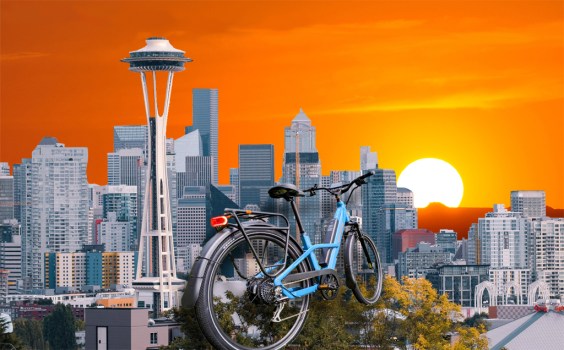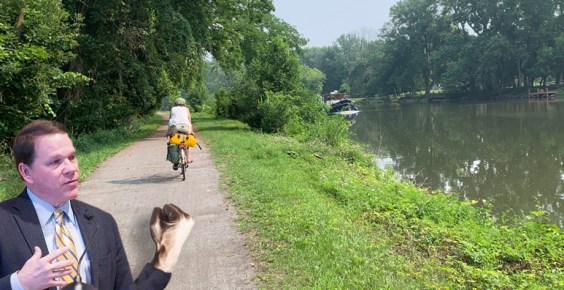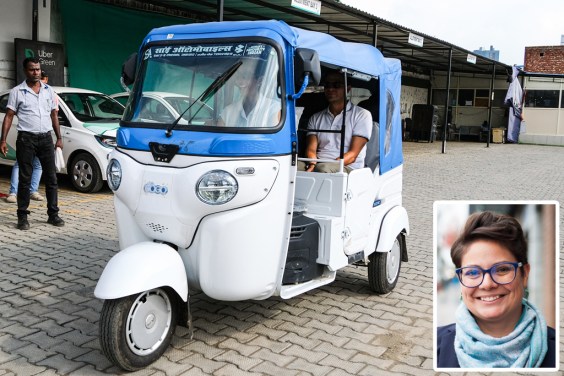At last week's Active Transportation Alliance awards ceremony (Streetsblog Chicago was an awardee), outgoing interim executive director Melody Geraci, who is being replaced by Amy Rynell, formerly of the Heartland Alliance, announced three big goals for the organization over the next ten years.
Geraci began by discussing Active Trans' recently released regional mode share report, a snapshot of how people are traveling in the region right now. "It's not pretty," she said. As it stands only 17 percent of Chicagoland residents get to work primarily by walking, biking, and public transportation, with a 36 percent rate in the city and but a mere 8 percent of suburbanites using sustainable transportation. She noted that there was a sharp decline in the Eighties and Nineties, and the numbers have not improved much since then. "So that's rough. We've got some work to do there."
Chicago has fallen below Seattle and Philadelphia in terms of the number of people of people walking, biking, and taking public transit to work. "Come on!" Geraci said. "Is that acceptable? I mean, Seattle maybe, but Philly? And look who's just below us -- we're second-to-last to LA!" She noted that Seattle has made major investments to public transportation, causing ridership to go up. She added that LA is making significant investments in rail right now thanks to a county referendum to raise the sales tax by a half cent to pay for it. "Are we going to be last to LA? Oh God no."
"So what we are going to do tonight is we are going to give you some big, hairy, audacious goals," Geraci said. "We believe that solving massive problems like engrained car-dependency requires ambitious goals." Here's what Active Trans proposes over the next decade.
A unified regional transit system
In addition to extending the Red Line south and upgrading the Metra Electric District line to rapid transit service, Active Trans wants a network of bus rapid transit lanes. "There's tons of room on these roads," Geraci said. "We have lanes that sit empty 23 hours a day where we could put buses that are going like this [snaps] through traffic." Of course, bus-only lanes are most useful during the times of day when car drivers want to use them and clog them, which is why bus lanes are politically challenging to implement. She cited Pace's Pulse express bus service, which launched last year on Milwaukee Avenue, as a step in the right direction.
Geraci added that Active Trans want the entire regional transit system to be wheelchair accessible by 2030, well ahead of the CTA's goal of making all stations accessible by 2038.
The group also wants a universal transit fare payment that lets customers use a single fare card. "Is that asking too much?" Geraci asked. "We're doing a mission to Mars but we can't have a single transit fare? That's ridiculous."
More bike lanes and car-free streets
Geraci showed footage of massive massive bike traffic on San Francisco's Market Street, which went car-free in January. Biking has already increased by about 25 percent. "It is time to dedicate fair amounts of space to these healthy, sustainable, and equitable modes," she said. "In 10 years we want 200 miles of new bike lanes in Chicago and 100 miles of new bus lanes, and we want dozens of car-free streets in the region."
Market St this morning pic.twitter.com/5z2GZI6P35
— Jeffrey Tumlin 🏳️🌈 (@jeffreytumlin) January 29, 2020
Using congestion pricing to pay for sustainable transportation infrastructure
"The [drivers] that use our roads do not pay their fair share," Geraci argued, citing "the harms that they cause to the environment, to society, to the roads that they drive on... and they're heavily subsidized. So we could get some of that money back." She noted that congestion pricing is "a fair and equitable pricing system" that currently being done in places like London and Singapore and Stockholm, raising hundreds of millions of dollars a year for sustainable transportation investments. New York City is already preparing to implement congestion pricing, and Seattle's considering it, she said. "Chicago needs to be next."
Geraci argued that the city's new ride-hail structure, which will help fund a congestion pricing study is "a little baby start... but it's not nearly enough. Charging fees to enter a downtown congestion zone is just one option. We also need to look at how we price our parking and our expressways. So the money is there, and we can do this."
What would you pick as your moonshot goals for local transportation advocacy? Let us know in the comments section.






